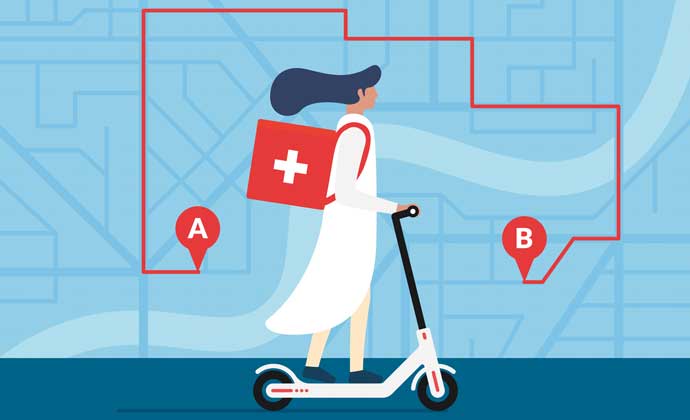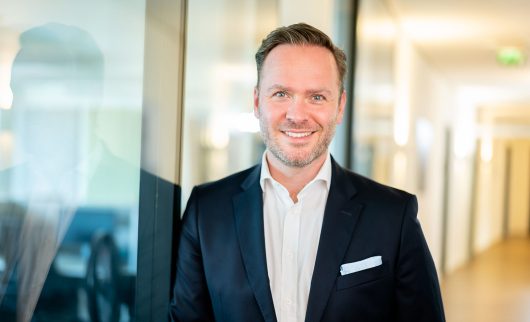
The last mile: the last kilometre to the customer in less than 60 minutes
You would like to know more?
Contact us
Just going to the supermarket often takes 10 minutes or more. In that time, some delivery services want to be able to bring your grocery order to the door. The start-ups naturally concentrate on urban areas. Such super express delivery would not be realistic otherwise. But how good are the delivery services? How extensive is the selection at Gorillas or Bring & Co? How large are the delivery areas? And how quickly do the services deliver? We’ll try to give an overview and venture an outlook on what this trend means for the pharmacy of the future.
Delivery in 10 minutes: how does it work?
The express services deliver from different warehouses that they’ve rented in city-centre locations. The rule is: the closer to the customer, the better. Some of these are shops that are no longer in use or empty office spaces. Those spaces that are centrally located but not easy to find for walk-in customers are especially interesting for the delivery services. Because walk-in customers or passers-by in front of the warehouse are only a nuisance when a delivery is pending.
After an order has been placed, the goods can be packed and handed over to an e-bike rider at the door within one to two minutes – thanks to an efficient warehouse structure, a small selection and clever logistics. The bike messenger then has another five to eight minutes to deliver the bag to the customer.
Online trade in medicines is growing; the e-prescription is just around the corner. What’s happening now?
This change is comparable to that of commerce in general. More and more transactional activities are being shifted to e-commerce channels. Consumers are demanding and enjoying the convenient ordering and delivery options. With regard to e-prescriptions, it will be even easier for patients to send their prescription digitally to a pharmacy and request delivery. Delivery times between 30 minutes and 60 minutes will become the new standard. In Germany, BD Rowa, Noventi, Sanacorp and Wort & Bild are involved here together with PHOENIX Group within the framework of gesund.de. DocMorris also has a last-mile fulfilment strategy with its marketplace and TeleClinic. In Italy, Pharmap has already been active since 2016 and delivers medicines to end customers within 60 minutes.

What do these changes mean for the pharmacy?
The number of prescription transactions coming into the pharmacy on foot across the sales floor will decrease. Fewer patients will be willing to pick up an e-prescription or the OTC medication they need in person at the pharmacy. Our estimates suggest that the frequency of prescription and OTC customers coming to the pharmacy themselves will reduce by 52%, more than half, by 2030. 57% of transactions will come directly to the pharmacy’s back office via an electronic route and will be delivered within 10 minutes via the new logistics capability.
Pharmacies will create more last-mile offerings by 2030
Micro Fulfilment Centres (MFC) in the pharmacy’s back office process the orders and provide the medicines. Door-to-door courier services and pick-up (click & collect) services will bridge the distance to the patient. Speed and proximity to the customer are important. But what exactly does Micro Fulfilment mean? Micro Fulfilment Centre (MFC) refers to the urban, pharmacy-connected, new logistics competence of pharmacies. There are many entrepreneurs (i.e., pharmacists with a sharpened commercial sense who have already recognised the signs of change in retail and interpreted them for the pharmacy). Such visionaries can usually be recognised by current projects which increasingly focus on the expansion of regional logistics competence with regard to micro-fulfilment centres. They are all driven by the same idea: how to organise the last mile as quickly, efficiently and profitably as possible in order to gain a competitive advantage over the threatening competition from large online mail-order companies.
Micro Fulfilment Centre in the pharmacy: what does it look like?
Basically, it’s about using the local proximity and branch structure of the on-site pharmacy to meet the newly emerging customer demands and expectations of pharmacy customers. These expectations are mainly driven by food retailing. The Micro Fulfilment Centre (MFC) of the pharmacy is usually attached to the main branch and is an extension of the back office of the pharmacy. Orders are fed directly into a pharmacy’s warehouse management system (WMS) and an order container is sent on the micro logistics route, as in pharmaceutical wholesale. The WMS can be a component of the merchandise management system or an extension of today’s common web shops. The orders are thus completed within 10 minutes of receipt and are available for collection from the pharmacy’s Click & Collect terminal or for the courier service. Intelligent controls sort the deliveries into the optimal logistical order and guide the e-bike or car messenger. The calculated arrival time, validated via Google Traffic, is fed back to the patient in real time via their order portal or web shop. The circle of urban micro logistics is closed.
The new salesroom in the pharmacy: what happens in the front office?
If one follows this trend, the conclusion is obvious that in the future, fewer customers will choose to walk to the pharmacy to complete a pure transaction. The online alternative in combination with the new delivery promises is very attractive. One asks: “What’s to come?” and “What more can the pharmacy do?”. The prospects are promising: entry into primary care with tests and vaccinations, a second opinion regarding contraindications and side effects, dermatological analysis and product advice, nutritional advice and support, intestinal health rebuilding advice – the list can go on with many more meaningful health topics. At the core, it’s always about competence counselling between people.
For the design of tomorrow’s medical practice, this means the creation of quiet consultation areas and flexible space design for temporary vaccination rooms with reception counters, as well as the possibility of opening the front office for evening events and providing it with seating. Micro-architecture is the buzzword for places within the pharmacy location. Flexible furnishing concepts would allow the team to redesign the space, i.e., the stage, in a short time. This idea can be compared to a gymnasium. Each school class would set up the parkour as it is intended for the respective sports unit. Everything that makes up the impression of the room for the customer can be changed with little effort and budget. The subject of light on the shelf plays an important role here – on the one hand to increase product focus and on the other hand to charge the room more emotionally; even outside opening hours, the assortment is perfectly staged by the light on the shelf.

About the author
Dirk Bockelmann is the author of this article and has been involved in global sales development and portfolio expansion and has been a trend scout at BD Rowa since 2014. Dirk has had a lasting impact on the success story of BD Rowa and is committed to finding new innovative trend themes from other areas of retail, healthcare and logistics and interpreting them for BD Rowa and the pharmacy market.
You might also be interested in
More time for the essentials
Manual warehouse maintenance takes up a lot of valuable working time. Thanks to the immense time savings, a dispensing robot no longer only pays off for larger pharmacies.
Goodbye repeat deliveries - welcome delivery capability
Delivery capability is an important issue for pharmacies. By increasing this, a pharmacy robot saves valuable resources every day.
Managing the pharmacy economically
The various financial aspects and financing options mean a dispensing robot is no longer just for larger pharmacies.


